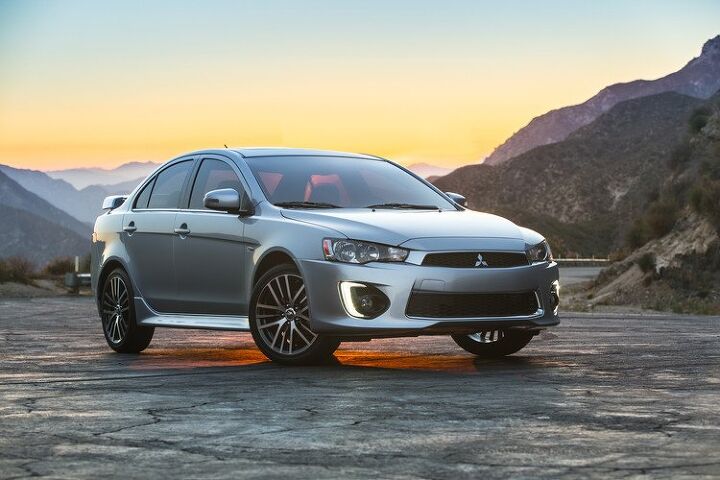With the Clock Ticking, Mitsubishi's Passenger Car Future is Still a Blank Slate

If you were to walk into a Mitsubishi showroom in the United States today, you’d be treated to two passenger cars, two utility vehicles and promises of more utility vehicles to come. Why, the 2018 Eclipse Cross is on the way! You know, the compact crossover named after a entry-level sports car?
If you’re looking for a Mitsubishi-branded car with more than three cylinders that won’t be extinct in a few months, you’re out of luck. In fact, if you’re hoping for any word on whether the brand will ever bring a new car to North America, you’ll have to wait until this fall, around the same time the long-in-the-tooth Lancer bows out of the U.S. market.
As the automaker, newly acquired by the Renault-Nissan Alliance, figures out what to do with itself, passenger cars have become an afterthought. The Galant and Diamante are dusty memories. The Lancer stops production in August (though the nameplate will continue on in China and Taiwan). There’s far more money in crossovers and SUVs, so that’s Mitsubishi’s main focus. Actually, hearing Mitsubishi CEO Trevor Mann tell it, that seems to be the only focus.
Speaking to Australia’s CarAdvice, Mann claims he’d like to see the brand remain in the car business, but nothing’s set in stone.
“I think we could not not focus on SUV, if you know what I mean,” said Mann. “We’ve got to focus on SUVs, because, one; it’s where our strength and heritage is, and, two; it’s where the market is going – not only in Australia, but globally.”
No argument there. The U.S. and Canadian public’s appetite for utility vehicles seems insatiable. However, that’s not to say no one bought the Lancer. While it’s a far cry from the sales figures posted back in 2002, over 14,000 Americans bought a Lancer last year, even as other compact cars outclassed it in terms of efficiency and power. As well, Mitsubishi says it has no plans to oust the subcompact Mirage from the continent, thanks to buyers looking to get behind the wheel of a new car for as little cash as possible. Over 22,000 of the tiny three-pots found a U.S. home last year.
Surely the brand can’t soldier on with just a subcompact as its only passenger car offering? Given market direction, it’s not a ridiculous notion. Earlier this year, Mann told Automotive News, “The answer to your prayers is not just adding nameplates. You’ve got to make sure the nameplates you’ve got are working for you.”
The CEO claimed a joint pickup venture with Nissan made sense for the American market, though he wouldn’t rule out the return of a sedan. Given the incredibly shrinking U.S. midsize market, it’s safe to say any new car would find itself in the compact class.
“The long debate is what do we do with the passenger car segment, where we’ve got a strong heritage product with Lancer,” Mann told CarAdvice.
The Lancer remains popular in Australia and Canada, and both countries hope to sell it as long as possible. North of the border, Lancers could languish in new car inventories until early 2018.
Before Mitsubishi can plan for a new North American car, it first must decide where the vehicle will come from. Now that the company has access to Renault-Nissan platforms and production facilities, it needs to ask itself how “Mitsubishi” it really needs to be. Going it alone left few options. Now, the company has several.
It looks like Mitsubishi brass will spend the summer brainstorming.
“We’ve have to crystallise this for when we announce the mid-term plan in October,” he said. “It’ll be announced then, but it’ll crystallise before then.”
[Image: Mitsubishi Motors]

More by Steph Willems
Latest Car Reviews
Read moreLatest Product Reviews
Read moreRecent Comments
- BlackEldo Why even offer a Murano? They have the Rogue and the Pathfinder. What differentiates the Murano? Fleet sales?
- Jalop1991 Nissan is Readying a Slew of New Products to Boost Sales and ProfitabilitySo they're moving to lawn and garden equipment?
- Yuda I'd love to see what Hennessy does with this one GAWD
- Lorenzo I just noticed the 1954 Ford Customline V8 has the same exterior dimensions, but better legroom, shoulder room, hip room, a V8 engine, and a trunk lid. It sold, with Fordomatic, for $21,500, inflation adjusted.
- Lorenzo They won't be sold just in Beverly Hills - there's a Nieman-Marcus in nearly every big city. When they're finally junked, the transfer case will be first to be salvaged, since it'll be unused.


































Comments
Join the conversation
The funny thing about the perception of Mitsubishi cars having poorer than Toyota reliability is that I often recall my brother's basic Lancer from 2005 with the 2.0 SOHC engine and 5-speed manual transmission. The car was neglected its whole life, had oil changes done at every 10 thousand miles, at best, using conventional oil, never had its timing belt replaced, was in a couple of accidents, and yet the drivetrain kept running strong, like new until the moment he got rid of it, which was about 150,000 miles. AC run like new. At that point, the car's suspension was shot and needed a rebuild, and together with the cost of replacing the timing belt and the clutch pack (so we're looking at the cost of repairs of 1500-2000USD, which exceeds the market value of the whole car), he just decided it's better just to donate this to a charity in exchange for a 500 dollar tax credit.
Being in the market for a car right now, I drove a Lancer GTS. Honestly, I liked it reasonably well. It's still on my list of possibilities, so I may end up with one. I hope Mits gets something Lancer-like, at least, in its lineup in the future. It would be sad if Mits turned into a trucklet-only maker.